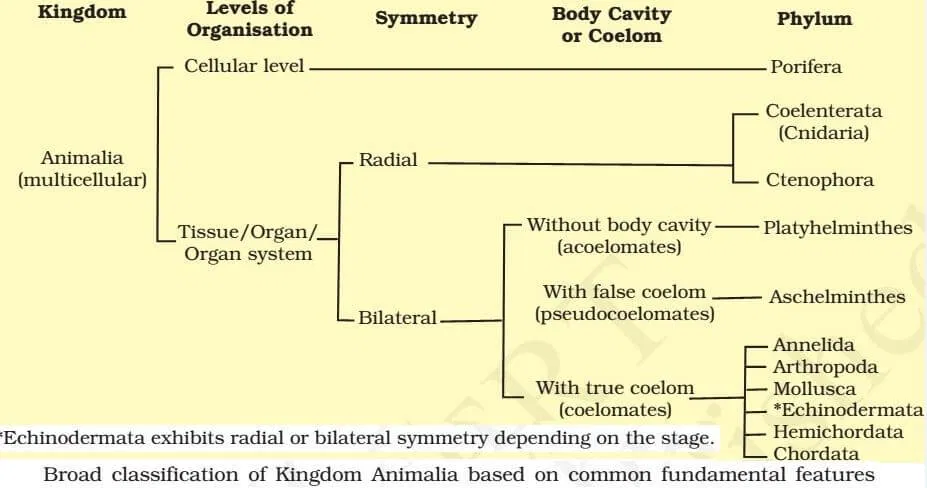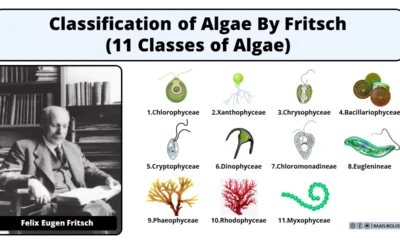Blog
Classification of Animal Kingdom | Free Biology Notes

In this article we will discuss about Classification of Animal Kingdom:- all phylum and their general characteristics features
R.H. Whittaker organized organisms into five kingdoms. He classified organisms based on cell structure, mode and source of nutrition and body design. The five kingdoms proposed by Whittaker are Monera, Protista, Fungi, Plantae and Animalia. In this article we will learn more about Classification of Animal Kingdom.
Kingdom Animalia
Kingdom Animalia constitutes all animals. Amongst the five kingdoms, the largest kingdom is the animal kingdom. Animals are multicellular eukaryotes. However, like plants, they do not possess chlorophyll or a cell wall. Therefore, members of the animal kingdom exhibit a heterotrophic mode of nutrition. Kingdom Animalia has been classified into ten different subphyla based on their body design or differentiation.
The different phylum of the Classification of Animal Kingdom are as follows:
- Porifera
- Coelenterata (Cnidaria)
- Ctenophora
- Platyhelminthes
- Nematoda
- Annelida
- Arthropoda
- Mollusca
- Echinodermata
- Hemichordata
- Chordata
Phylum Porifera
Porifera means organisms with holes. They are commonly known as Sponges. Features of the poriferan are:
- Non-motile, multicellular organisms with a hard outer skeleton.
- Have a porous body.
- Pores on the bodies create a canal system which helps in the circulation of substances.
- Not differentiated into head and tail; do not have a well-developed organ or organ system.
- Include marine habitat.
- Examples of phylum Porifera include- Spongilla, Sycon.
Phylum Coelenterata (Cnidaria)
The term Coelenteratais derived from the Greek word “kilos” which means hollow-bellied. Their features are:
- Have a hollow body cavity.
- The body is differentiated into two ends.
- Includes all aquatic animals.
- The body is made of two layers of cells: inner and outer linings.
- Live in colonies (corals) as well as solitary (Sea anemone).
- Examples of phylum Coelenterata include – Hydra, Jellyfish.
Phylum Ctenophora
- Ctenophora are also known as comb jellies
- Ctenophora composed of two layers of tissue known as ectoderm and endoderm
- Epidermis is made of Sensory cells, mucus secreting cells, lasso cells and nerve cells
- Gastrodermis is layered tissue with Long storage cells, germ cells and photo cells
- Tentacles are present.
- Solid and adhesive cells are called lasso cells which help in catching prey
- Examples of phylum Ctenophora include– Hormiphora (The Sea Walnut), Pleurobrachia (The Sea gooseberry) and Beroe (Swimming eye of cat)
Phylum Platyhelminthes
Platyhelminthes are commonly known as flatworms. Their features are:
- Dorsoventrally flattened body.
- Complex and have differentiated body structure.
- Tissues are differentiated from three layers of cells and are triploblastic.
- Do not have a true internal cavity or coelom.
- Have bilateral symmetry.
- Either free-living (Planaria) or parasitic (liver flukes).
- Examples of phylum Platyhelminthes include -Tapeworm, Planaria.
Phylum Nematoda
Phylum Nematoda consists of nematodes or roundworms. Their features are:
- Nematodes have a cylindrical body.
- Bilaterally symmetrical and triploblastic.
- Have pseudocoelom, a false body cavity.
- Parasitic and causes diseases such as elephantiasis, ascariasis.
- Examples of phylum Nematoda include – Ascaris, Wuchereria.
Phylum Annelida
Annelids are commonly known as segmented or ringed worms. They have the following features:
- Have a segmented cylindrical body.
- The body is differentiated into head and tail.
- Bilaterally symmetrical and triploblastic.
- Have a true body cavity.
- Habitat: marine, freshwater and land.
- Examples of phylum Annelida include – Earthworm, Leech.
Phylum Arthropoda
Arthropod means jointed legs. Animals which have jointed appendages belong to this phylum. This is the largest phylum in the animal kingdom. Other features are:
- They are bilaterally symmetrical.
- Have jointed appendages, exoskeleton and a segmented body.
- Have well-differentiated organ and organ system.
- Have an open circulatory system, but do not have differentiated blood vessels.
- Examples of phylum Arthropoda include – Spiders, butterflies, and mosquitoes.
Phylum Mollusca
Phylum Mollusca consists of a large group of animals. Features are:
- Bilaterally symmetrical and triploblastic.
- Less segmented body.
- Well-developed organ and organ system.
- Typically, open circulatory system.
- Limbs are present.
- Examples of phylum Mollusca include- Snails and octopus.
Phylum Echinodermata
The term Echinodermata is derived from the Greek words, echinos meaning hedgehog and derma meaning skin. Thus, echinoderms are spiny-skinned animals.
- Radial symmetry and triploblastic.
- Have true coelom.
- Have hard calcium carbonate skeleton structure.
- Free-living marine animals.
- Examples of phylum Echinodermata include- Sea urchins, starfish.
Phylum Hemichordata
The characteristics of phylum Hemichordata are as follows:
- The body is soft, fragile, and divided into a proboscis.
- The epidermis is single-layered.
- It comprises worm-like marine animals with an organ-system level of organization.
- They have an open circulatory system.
- They respire through gills since they are marine.
- They have separate sexes and external fertilization is seen.
- Development is direct.
- Examples of phylum Hemichordata include- Balanoglossus, Saccoglossus, Cephalodiscus.
Phylum Chordata
The Chordates possess the following characteristics:
- They are bilaterally symmetrical, triploblastic with an organ-system level of classification.
- They possess a notochord and a nerve cord.
- The circulatory system is closed type.
- Phylum Chordata can be divided into the following sub-phyla: Urochordata, Cephalochordata & Vertebrata
- Examples of phylum chordata include- Amphibia, Reptilia & fishes

 Blog6 months ago
Blog6 months ago[PPT] Human Reproduction Class 12 Notes
- Blog6 months ago
Contribution of Indian Phycologists (4 Famous Algologist)

 Blog6 months ago
Blog6 months agoCell The Unit of Life Complete Notes | Class 11 & NEET Free Notes
- Blog6 months ago
PG TRB Botany Study Material PDF Free Download

 Blog6 months ago
Blog6 months ago[PPT] The living world Class 11 Notes

 Blog6 months ago
Blog6 months agoJulus General Characteristics | Free Biology Notes

 Blog6 months ago
Blog6 months agoClassification of Algae By Fritsch (11 Classes of Algae)

 Entertainment6 months ago
Entertainment6 months agoIbomma Bappam: Redefines Telugu Streaming Trend














